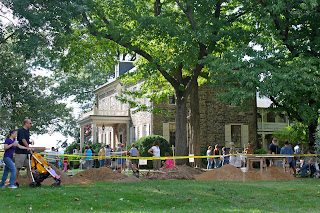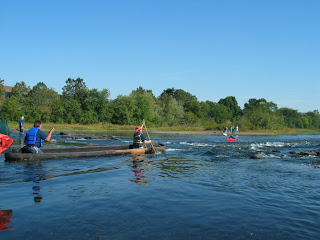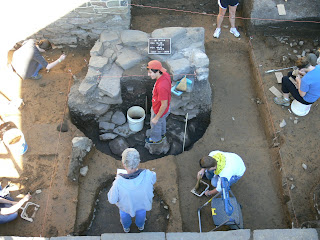 The aftermath of Nicole-
The aftermath of Nicole-  Pumps and siphons help get the clean-up job done
Pumps and siphons help get the clean-up job done
This is the site that greeted us this morning at Fort Hunter! We had a lot of water and some “natural” visitors that we removed from our plastic lined units. We’ve had quite an array of visitors from the snake on the side porch to these little critters- Mother Nature has reminded us that she is in control!



Our regular followers know that last week we promised to open the feature currently interpreted as a well. What we didn’t plan for was tropical storm Nicole and the deluge of rain received in the mid-state this week. Most of our energies have been spent instead on pumping and siphoning water from our large excavation block. Despite the weather we were able to work at the site a full day on Wednesday. This allowed us time to clean and profile the south wall of our feature, map and recover over a hundred pieces of fire cracked rock, and provide a field experience for our F&M students and Boy Scouts from Troop 88, Cumberland County. At the museum Elizabeth Wagner participated in a program for Home Schooled children from Central PA which was well attended by over 120 students and parents. A busy week-despite the weather!
 Boy Scout Troop 88 working on their Archaeology Merit Badge
Boy Scout Troop 88 working on their Archaeology Merit Badge
 Profile of south wall of "well"
Profile of south wall of "well"Today is the first day of October and the beginning of Archaeology Month in Pennsylvania. This kicks off a number of programs around the state offered by chapters of The Society for Pennsylvania Archaeology. A link to these programs is at
http://www.pennsylvaniaarchaeology.com/archaeologymonth.html. Some of our followers are members of The Society for Pennsylvania Archaeology and the Pennsylvania Archaeology Council
http://home.earthlink.net/~pacweb/ . These organizations are essential in helping to spread the “word” of archaeology throughout the Commonwealth of Pennsylvania. Many of you have enjoyed our brochures that we hand out at our public outreach programs, some of you have posters from Archaeology Month hanging on your wall. We owe many thanks to these organizations which help to pay the costs of printing this information and disseminating it to the public.

As part of Archaeology Month we will be available at Fort Hunter on Sunday, October 3rd for Indian Days. The program will focus on Native Americans and is an informative and entertaining event. We will be excavating, trying to make up for lost time this week. Stop by and see our progress as we start to tackle our “well” feature.
Pennsylvania Indians Festival
Curious about how Pennsylvania Indians once lived? Visit a wigwam, learn about the food Indians grew and gathered, how they hunted and made fire. See their tools, dances, music & beadwork. See the clothing, animals and plants they used. Food stand and a specialized museum shop.
When: Sunday, October 3, 1-4 pm
Where: Fort Hunter Park
Admission: $3 per person, children 5 & under free Pre-register for Special Scout Hour –
http://www.forthunter.org/.
 Dr. Kurt Carr instructs proper technique for holding the atlatl at Indian Day 2009
Dr. Kurt Carr instructs proper technique for holding the atlatl at Indian Day 2009
Friday, October 1st- Look..... we started the "well"!

Come check our progress on Sunday, October 3rd!
For more information, visit
PAarchaeology.state.pa.us or the Hall of Anthropology and Archaeology at
The State Museum of Pennsylvania .

 Eastern States Archaeological Federation logo
Eastern States Archaeological Federation logo































 Come check our progress on Sunday, October 3rd!
Come check our progress on Sunday, October 3rd!